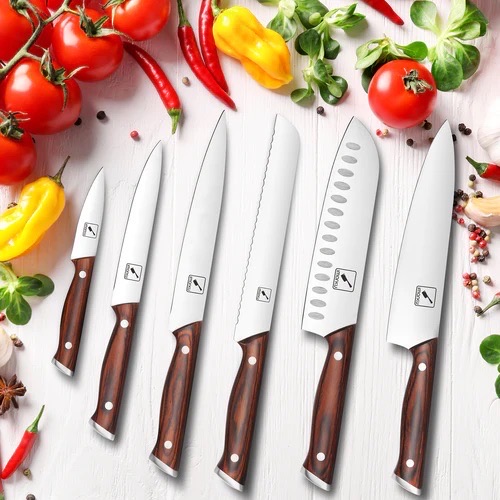Knife manufacturers know that during food preparation, different ingredients need to be prepared. There are knives made specifically for slicing and peeling fruit, such as paring knives or even paring knives. There are also knives designed for precise cuts of meat, such as butcher knives that can cut through some bones. The shape, length, and width of a knife greatly determine its use and capabilities.
No matter what you want to cook, whether it’s meat, fish, fruit or vegetables, you can do it with a chef’s knife. In this article, we’ll discuss everything you need to know about a chef’s knife and how to choose one for yourself.
What is a Chef’s Knife?
Most individuals and chefs refer to it as a kitchen powerhouse due to its versatility and multipurpose nature. These features make it suitable for different cooking tasks. This knife has a typically long blade, about 8 inches. Additionally, it features carbon steel and stainless steel materials that enhance its durability and functionality. If you are interested in Japanese knives, click here for more information.
In appearance, it has a prominent point with sharp edges and sloping curves. The sloping, curvilinear look allows for the execution of its rocking motion cutting technique. This is a knife for any cook or head chef because it fulfills all other knife needs. For example, you can use it in the kitchen to slice, chop and chop food or ingredients while preparing any meal.
What is a chef’s knife used for?
A chef’s knife is a must-have kitchen cutlery for different cutting needs. These knives have excellent multi-purpose functions to help you meet different kitchen cutting needs. For example, they are ideal for smaller cutting and chopping tasks, such as mincing garlic, shredding carrots, and chopping herbs or ingredients.
Plus, they’re great for larger tasks in the kitchen, like nuggeting chicken, dicing large onions or cucumbers, and slicing ham. Thanks to its modern design and appeal, chef’s knives are commonplace in most modern American home kitchens. In addition to being able to pair with other kitchen knives, these pieces are a suitable choice to enhance your kitchen work when you have different cutting or dicing needs.
For detail-oriented tasks like fine slicing and peeling, you can pair this kitchen knife with a paring knife for best results. You can also pair the blade with a utility knife for simple tasks like slicing a loaf of bread. Packed with features and functions, this knife can be easily lined up or paired with other blades to get the best results for different cutting or slicing needs.
Finally, most people have been asking if you can use this knife for your carving needs. Yes, a chef’s knife is an excellent choice for your carving needs. You can use these knives to cut meat and separate meat from bone. It gives you better options for carving different types of meat in your kitchen. You can even replace kitchen appliances like electric routers and carving knives with chef’s knives.
3 Things to Consider When Buying a Chef’s Knife
When you first hold the knife in your hand, you should feel how well it fits in your hand. If it doesn’t feel right, move on.
Weight
To determine the optimal weight for your knives, you will need to try a few different knives. A good chef’s knife cuts through food more easily because it “falls” harder. Another way of saying this is that lighter chef’s knives flow more freely, allowing you to handle the knife more skillfully.
Balance
The definition of “perfect balance” is that the beholder sees benevolence and the wise sees wisdom. By holding the knife by the handle, you can determine its balance. If the weight on the back of the handle and blade feels uncomfortable, it probably isn’t for you. If your knife is out of balance, you will have to do more work. Left-right balance is also important. The knife should not feel unstable when you press it down, as if it wants to tip to one side or the other.
Size
Because of its adaptability, the 8-inch chef’s knife is by far the most popular knife for home cooks. The longer blade of the 10-inch cutter can cut more volume, however, it can be intimidating. A 6-inch chef’s knife, like a paring knife like this one, has some flexibility, but it’s less nimble when working in large batches or slicing through anything huge, like watermelon.
How to Sharpen a Chef’s Knife
Once you’ve purchased your chef’s knife, we’ll provide all the maintenance you need to ensure you maintain your knife’s functionality and enhance its durability. Sharpening your knife is very important to get a sharp cutting edge to enhance its full functionality. When sharpening these knives, choosing the right sharpening method is imperative.
The best way to sharpen these blades is with the hon method. This sharpening mechanism involves using a proper honing rod and sharpening with a whetstone.
In addition to using honing sticks and whetstones, experts suggest that you can also choose an electric sharpener. They’re the best choice for your sharpening needs, but they won’t achieve similar sharpness or precision to manual sharpening results.
If the sharpening requirements are met, you can enhance the functionality of your knives with the sharpening described above. However, if they are not available or you are unsure of the proper sharpening process, you can seek the services of a professional sharpener. These guys have the proper skills and the right equipment to sharpen knives and get a precise cutting edge.
Conclusion
A chef’s knife is one of the many vital tools that any home cook or professional cook must have at all times. Choosing the right knife for you and your needs is critical to serving the best meals to your family or customers.

